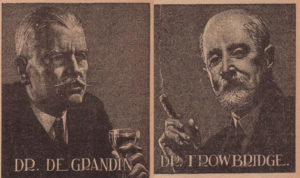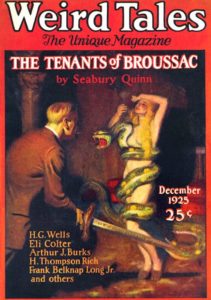There’s nothing better than reading a mystery that has a ghost or a monster in it. And that’s essentially what the occult detective genre is. A fusion of the traditional detective whodunit and the horror story.
Now, I will admit my description is a bit of an oversimplification. But for now, let’s run with it.
The prince, if not the king, of the ghostbusters is undoubtedly Jules de Grandin. Only Thomas Carnacki is perhaps more well-known.
Carnacki was the creation William Hope Hodgson. And Carnacki pastiches are almost as numerous as those of Sherlock Holmes. I’ll talk about Carnacki in another post.
Jules de Grandin and his “Watson”, Dr Trowbridge, were the creation of Seabury Quinn. They appeared in 92 stories and 1 novel, in the pages of Weird Tales magazine. From 1925 to 1951, the exploits of this dynamic duo thrilled readers of the Unique Magazine like no other.
GW Thomas, on his now defunct website, archived here, summarized de Grandin in this way:
Jules de Grandin is the master of the outrageous detective genre. Everything about him is over-the-top from his Hercule Poirot moustache to his outbursts of stilted French. De Grandin and his Watson-like companion, Dr. Trowbridge, live in Harrisonville, NJ, a town haunted by monsters, mad scientists and all manner of weird phenomena. As with Carnacki, not all of de Grandin’s adversaries were supernatural. The de Grandin stories appeared only in Weird Tales, where they were the most popular of all characters, beating even Conan the Cimmerian and Lovecraft’s Cthulhu Mythos.
From what I’ve read, Mr Thomas was spot on. Of all the writers who contributed to Weird Tales, Seabury Quinn was the most popular and, as a result, was paid at a higher rate.
Of all the characters to appear in WT, de Grandin was the most popular. And it was the promise of a serialized Jules de Grandin novel that held off the debt holders from shutting the magazine down in 1931.
Seabury Quinn and Jules de Grandin dominated Weird Tales. Quinn’s only real challenger was Allison V Harding in the 1940s.
Yet, Quinn was unfairly maligned and minimized by the Lovecraft Circle (because HPL didn’t like Quinn’s style and perhaps the fact that he wrote for money) and it has only been within the last dozen or so years that Quinn has come under reassessment. And I’m glad he has, because he was a good writer and should not be forgotten.
What I find interesting is that for all of de Grandin’s popularity, he was the product of having to meet a deadline. Quinn, himself, wrote:
One evening in 1925 I was at that state that every writer knows and dreads; a story was due my publisher, and there didn’t seem to be a plot in the world. Accordingly, with nothing particular in mind, I picked up my pen and — literally making it up as I went along — wrote the first story which appears in this book.
I don’t know what collection of stories GW Thomas got that quote from, but I find it simply delightful. Necessity is indeed the mother of invention.
I own the 5 volume Nightshade Books edition of The Complete Tales of Jules de Grandin. You can, of course, find them on Amazon.
I’ve read over a dozen of the stories and I like them. The fun quotient is high and each story will give you an enchanting hour’s worth of entertainment. What more can you ask from a story?
Should you begin reading the de Grandin tales, and I encourage you to do so, keep in mind they were written for a monthly or bimonthly magazine. The storylines are somewhat formulaic. Certainly written to an established pattern. But then, so were the tales of Sherlock Holmes’ exploits.
I would recommend not reading more than a couple stories at one sitting in order to keep their charm and appeal fresh. Plus, doing so, will give you many, many days and weeks of reading pleasure. And who doesn’t want that?
Seabury Quinn was a superb storyteller. He had over 500 publishing credits during his lifetime, and was himself a magazine editor.
Approaching Quinn as a reader, I can say that he delivers the goods. He succeeds in transporting me to another time and place, and provides the entertainment value I’m looking for.
Approaching Quinn as a writer, I sit at the feet of a master and learn the craft of how to tell a story so that it will move the reader.
Last Christmas, I read Quinn’s Roads (his classic Christmas tale) to my sister and nephew. So captivating was Quinn’s prose that my nephew, at one point, uttered an interjection of awe. If only all of us writers could have that happen!
The occult detective genre is rich with exciting and spooky and chilling stories. The exploits of Jules de Grandin and Dr Trowbridge deliver on all counts.
Comments are always welcome. And until next time, happy reading!
Share This!
